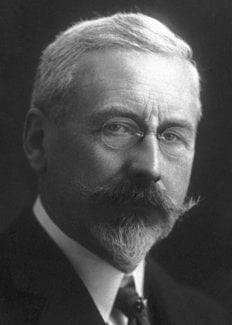Charles Edouard Guillaume
Biographical

Charles-Edouard Guillaume was born at Fleurier, in the Swiss-Jura, on February 15, 1861. His grandfather had left France for political reasons during the Revolution and established a watchmaking business in London. The business was carried on by his three sons but Charles’ father, Édouard, eventually returned to settle in Fleurier.
Guillaume received his early education in Neuchâtel before going to the Zurich Polytechnic where he obtained his doctor’s degree. He spent a short time as an officer in the artillery before entering the International Bureau of Weights and Measures, as an assistant, in 1883. He became Associate Director in 1902 and from 1915 until his retirement in 1936, he was Director of the Bureau. He remained as Honorary Director from 1936 until his death.
During his brief military career, Guillaume studied mechanics and ballistics but his earliest investigations at the bureau were with thermometry. He carried out important investigations on corrections to mercury-in-glass thermometers and he was responsible for the detailed calibration of thermometers used at the Bureau in the establishment of the thermal expansions of the standards of length. He was concerned in initial work on the International Metre and undertook a determination of the volume of one kilogram of water by the contact method.
A chance observation by Guillaume on the coefficient of expansion of nickel-iron alloys led to a systematic investigation of a whole series of alloys and the discovery of invar, an alloy with a very low coefficient of expansion; elinvar, for which the thermoelastic coefficient is practically zero, i.e. Young’s modulus constant, over a considerable temperature range; together with other useful alloys. The applications of invar were quickly recognized and the material was used in rapid methods for the measurement of geodetic baselines. The alloy is widely used in instruments of precision, such as thermostats and pendulums of astronomic clocks. Guillaume’s total compensating balance for high-grade watches and chronometers, which eliminates the secondary error, was perfected by an elinvar hair spring.
Guillaume’s work is recorded in many papers published by the Bureau and he has written, amongst other works, Études thermométriques (Studies on Thermometry, 1886), Traité de thermométrie (Treatise on Thermometry, 1889), Unités et Étalons (Units and Standards, 1894), Les rayons X (X-Rays, 1896), Recherches sur le nickel et ses alliages (Investigations on Nickel and its Alloys, 1898), La vie de la matière (The Life of Matter, 1899), La Convention du Mètre et le Bureau international des Poids et Mesures (Metrical Convention and the International Bureau of Weights and Measures, 1902), Les applications des aciers au nickel (Applications of Nickel-Steels, 1904), Des états de la matière (States of Matter, 1907), Les récent progrès du système métrique (Recent progress in the Metric System, 1907, 1913). His book Initiation à la Mécanique (Introduction to Mechanics) has been translated into several languages.
He was appointed Grand Officer of the Legion of Honour and received honorary Doctor of Science degrees from the Universities of Geneva, Neuchatel and Paris. He was a President of the Société Française de Physique and a member, honorary member or corresponding member of more than a dozen of the leading scientific academies of Europe.
Charles-Édouard Guillaume married Mlle. A.M. Taufflieb in 1888. They had three children. He died on May 13, 1938.
This autobiography/biography was written at the time of the award and first published in the book series Les Prix Nobel. It was later edited and republished in Nobel Lectures. To cite this document, always state the source as shown above.
The Nobel Foundation's copyright has expired.Nobel Prizes and laureates
Six prizes were awarded for achievements that have conferred the greatest benefit to humankind. The 14 laureates' work and discoveries range from quantum tunnelling to promoting democratic rights.
See them all presented here.
